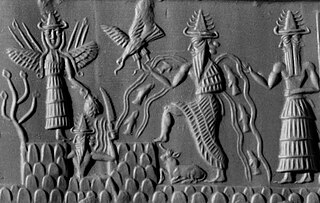 W
WIn Aztec mythology, Creator-gods are the only four Tezcatlipocas, the children of the creator couple Ometecuhtli and Omecihuatl "Lord and Lady of Duality", "Lord and Lady of the Near and the Close", "Father and Mother of the Gods", "Father and Mother of us all", who received the gift of the ability to create other living beings without childbearing. They reside atop a mythical thirteenth heaven Ilhuicatl-Omeyocan "the place of duality".
 W
WThe following is a list of gods, goddesses and many other divine and semi-divine figures and creatures from ancient Basque mythology.
 W
WThe following is a list of Australian Indigenous Australian deities and spirits.
 W
WFigures in Irish mythology include the following:
 W
WDeities in ancient Mesopotamia were almost exclusively anthropomorphic. They were thought to possess extraordinary powers and were often envisioned as being of tremendous physical size. The deities typically wore melam, an ambiguous substance which "covered them in terrifying splendor" and which could also be worn by heroes, kings, giants, and even demons. The effect that seeing a deity's melam has on a human is described as ni, a word for the "physical creeping of the flesh". Both the Sumerian and Akkadian languages contain many words to express the sensation of ni, including the word puluhtu, meaning "fear". Deities were almost always depicted wearing horned caps, consisting of up to seven superimposed pairs of ox-horns. They were also sometimes depicted wearing clothes with elaborate decorative gold and silver ornaments sewn into them.
 W
WThis is an index of Egyptian mythology articles.
This is a list of deities playing a role in the Classic, Post-Classic and Contact Period (1511–1697) of Maya religion. The names are mainly taken from the books of Chilam Balam, Lacandon ethnography, the Madrid Codex, the work of Diego de Landa, and the Popol Vuh. Depending on the source, most names are either Yucatec or Kʼicheʼ. The Classic Period names are only rarely known with certainty.
 W
WMeitei people, being the predominant ethnic group in the Himalayan kingdom of Manipur, has diverse cultural contacts with diverse communities of other nations since ancient times. The case is the same with Meitei folklore as well as Meitei culture. This is a list of the creatures of Ancient Meetei folklore. This doesn't include the list of deities in Meitei mythology, for which see Lists of deities in Sanamahism and Meitei deities.
 W
WMythological objects encompass a variety of items found in mythology, legend, folklore, tall tale, fable, religion, spirituality, superstition, paranormal, and pseudoscience from across the world. This list will be organized according to the category of object.
 W
WRape is a common topic in history and mythology. A list of notable victims from history and mythology includes:
 W
WThe Roman deities most familiar today are those the Romans identified with Greek counterparts, integrating Greek myths, iconography, and sometimes religious practices into Roman culture, including Latin literature, Roman art, and religious life as it was experienced throughout the Empire. Many of the Romans' own gods remain obscure, known only by name and sometimes function, through inscriptions and texts that are often fragmentary. This is particularly true of those gods belonging to the archaic religion of the Romans dating back to the era of kings, the so-called "religion of Numa", which was perpetuated or revived over the centuries. Some archaic deities have Italic or Etruscan counterparts, as identified both by ancient sources and by modern scholars. Throughout the Empire, the deities of peoples in the provinces were given new theological interpretations in light of functions or attributes they shared with Roman deities.